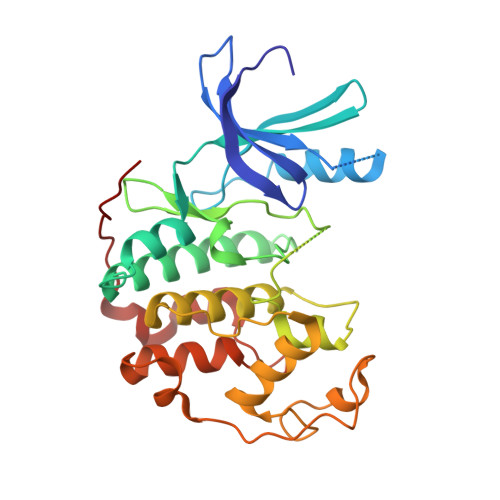Identification of N-(4-Piperidinyl)-4-(2,6-Dichlorobenzoylamino)-1H-Pyrazole-3-Carboxamide (at7519), a Novel Cyclin Dependent Kinase Inhibitor Using Fragment-Based X-Ray Crystallography and Structure Based Drug Design.
Wyatt, P.G., Woodhead, A.J., Berdini, V., Boulstridge, J.A., Carr, M.G., Cross, D.M., Davis, D.J., Devine, L.A., Early, T.R., Feltell, R.E., Lewis, E.J., Mcmenamin, R.L., Navarro, E.F., O'Brien, M.A., O'Reilly, M., Reule, M., Saxty, G., Seavers, L.C.A., Smith, D., Squires, M.S., Trewartha, G., Walker, M.T., Woolford, A.J.(2008) J Med Chem 51: 4986
- PubMed: 18656911
- DOI: https://doi.org/10.1021/jm800382h
- Primary Citation of Related Structures:
2VTA, 2VTH, 2VTI, 2VTJ, 2VTL, 2VTM, 2VTN, 2VTO, 2VTP, 2VTQ, 2VTR, 2VTS, 2VTT, 2VU3 - PubMed Abstract:
The application of fragment-based screening techniques to cyclin dependent kinase 2 (CDK2) identified multiple (>30) efficient, synthetically tractable small molecule hits for further optimization. Structure-based design approaches led to the identification of multiple lead series, which retained the key interactions of the initial binding fragments and additionally explored other areas of the ATP binding site. The majority of this paper details the structure-guided optimization of indazole (6) using information gained from multiple ligand-CDK2 cocrystal structures. Identification of key binding features for this class of compounds resulted in a series of molecules with low nM affinity for CDK2. Optimisation of cellular activity and characterization of pharmacokinetic properties led to the identification of 33 (AT7519), which is currently being evaluated in clinical trials for the treatment of human cancers.
- Astex Therapeutics Ltd, 436 Cambridge Science Park, Milton Road, Cambridge, CB4 0QA, United Kingdom. p.g.wyatt@dundee.ac.uk
Organizational Affiliation:


















